phd preparation diaries: our notebooks, ourselves
notes on what it means to fall in love with stationery
Thank you so much to my paid subscribers who make everything I write here possible. That’s doubly true for big translation and commentary projects like this one, which take a lot of work and will all be posted for free. If you’d like to read more of my writing and support my work, you can become a paid subscriber for £4 per month and get an extra essay per week. Coming up soon we have imaginary Oxfords in literature. If you would like to support me but aren’t able to become a regular paid subscriber, I also have a ko-fi tip jar here.
I go through phases with the PhD preparation diaries. Sometimes I look back at the last few weeks and go ‘this is all kinda heavy’. My budgeting issue took more out of me than I expected, and I honestly can’t tell you why a walk through my budget app made me more miserable to write than the one about my body image issues. So we’re shaking ourselves out and doing something fun this time around.
We’re talking about notebooks.
At present, my entire TikTok feed is people offering to take me on ‘a tour of my notebook ecosystem’. I’ve saved dozens to send to my friends and then held back from pressing send because I fear my friends have better things to do than watch hours of these videos with me. There’s something hypnotic about it for me, though. A joke I make a lot is that I’m not doing a PhD because of the opportunity to write lovely things on lovely stationery, but I’m not not doing that. There was a bunch of discourse a few years ago about the phrase ‘romanticize your life’ — and I will not be repeating that discourse, because we’ve all got better things to do on a summer weekend day. I’ll just say I reckon it’s more fun to be in love with something than not to be in love with something, all things being equal, if you’ve got the room in your schedule.
When I was dreaming up this essay, I read a fantastic academic paper called The Symbolic Life of the Moleskine Notebook: Material Goods as a Tableau for Writing Identity Performance, by Cydney Alexis and published in the journal Composition Studies. I absolutely loved its theoretical perspective on how emotions about writing get bound up in, and literally inscribed on, the surface of the notebook object. The last few weeks, I’ve been reading a lot about manuscript studies and scribal practice for my PhD pre-reading, and it was fascinating to me to flip that lens around on the notebook I’m taking those notes in. Alexis talks about notebooks as ‘a tableau onto which people project their hopes and fears about writing’, and describes how notebooks can be used as a tool to envision and then become a new version of the self. When I scroll my TikTok feeds and watch people explaining their journaling set-ups to me, they are performing an identity as a notebook user and I’m learning how to perform along with them. I don’t think this being performative makes any of this bad or stupid. It’s an equivalent level of unnatural as my boyfriend performing being a football fan.
I’ve talked a bunch here before about the unique psychological tensions of being a part-time, non-traditional grad student. I’ve talked about the risks that come with not feeling ‘real’ or feeling ‘less than’ compared to the ‘real’ PhD students. But do you know when I stop worrying about all that, when I feel absolutely real, and in the right place at the right time, happy and at peace with everything I’m doing? When I’m writing by hand in a notebook. Sitting in my office on my lunch hour, taking notes from a JSTOR paper in my lovely notebook with my lovely fountain pen, I wouldn’t swap my life for anyone else’s in the world. Or maybe I would, but only a person with more money for fancy inks.
So this week’s essay is an ode to notebooks in general and my notebooks in particular. I might be putting too much emotion on these notebooks, but they’re all warm fuzzy emotions, and I think that’s a pretty good state to be in.
Today we’re going to talk about all my notebook uses, how I approach each of them, and my nitty gritty opinions on paper, bindings and pens. Stationery nerds will love it. Others will despair.
Why write handwritten notes?
Writing longhand wasn’t an option at all for me for close to ten years. When I was nineteen-ish, I got diagnosed with a condition that meant all the cartilage in my wrists hated me and I was in constant pain when I tried to write at all. My doctor told me the pain would probably lessen if I could try and stop typing, writing with pens, or holding physical books. That’s not very useful information to be told halfway through an English literature degree. So I got approved for funding for dictation technology through the Disabled Students’ Allowance (the main form of disability support for UK university students), and I took all my exams on computers so I wouldn’t have to try and hold a pen. I don’t think I owned a pen at all for a few years there. After my degree I kept not writing and I had to use strange Star Trek-looking computer mice so I could use the computer without bending my wrists the usual ways.
So I loved notebooks but I loved them from afar. I’d pretty much given up hope of ever being a longhand person again until I tried writing with pens again, on a whim, sometime last year. I was surprised to find that, within certain limits, I actually could write notes in notebooks. It was like the moment in a romance novel when you realise your ex from all that time ago really might still think of you that way. We could get back together.
I’d been using paper planners for to do lists for a little while, which I’m not really counting as part of my notebook life because it was only a couple of words of writing at a time. But I titled up my first commonplace book last autumn, and we’re now halfway through volume four of my commonplace book (yes, I have an elaborate spreadsheet indexing system to track what’s in what volume).
On my MA-PhD ‘gap year’ I’ve been dabbling in taking academic notes by hand and I’ve really, really loved it. During my last degree, I found that taking notes electronically made it really quick and easy to generate vast numbers of pages of notes and then fail to find or use anything in there. When you’re reading an electronic book and taking notes in a splitscreen google doc, it’s so easy to say, ‘This page is useful, guess I’ll copy the whole thing’. Writing my dissertation, I amassed so many notes they became actively unhelpful.
Writing by hand is romantic and beautiful but it also makes me take fewer notes, and I think that’s wonderful. Painstakingly copying out a whole paragraph with a pen takes ages, causes me a non-zero amount of hand pain, and wastes paper I can ill-afford. So do I really want to copy out an entire paragraph? If I do, if it’s really really fucking important, then taking the time to meditatively scribe it out helps me process and remember why it mattered and that makes it easier to work with those ideas later. 90% of the time I don’t think the work is worth it and I write down a handful of keywords, or nothing. If I’d written my MA dissertation with notes this minimalistic, life would have been a lot easier.
Pens
Writing with a pen isn’t completely pain-free for me, and it probably never will be. It’s unimaginably better than it was, and I’ve had a level of improvement I couldn’t have imagined when I was twenty one or so, but it doesn’t not hurt. I’ve only been using my new fountain pen a little while but I love how the weight of the pen does all the work and I don’t have to press onto the page at all. I’m feeling very optimistic about this being a long-term game changer for me.
Choosing my fountain pen, I spent a while on reddit threads for people who know a lot more about pens than me. I didn’t want to spend a bazillion pounds (at this time) and I ended up getting this Hongdian fountain pen from Amazon. I have no idea if we can call this a recommendation or not, as I haven’t used another fountain pen since school. For all I know, every other pen in the world is better than this one. But it cost £20 and I’m very happy with it. It comes with a sort of syringe-refill cartridge, enabling you to refill the pen from ink bottles through the nib. I really wanted a fountain pen I could easily use with bottled ink — for a mix of aesthetic and environmental reasons.
The ink I got to use it with was the Diamine Oxford blue ink. I got it after falling in love with a lot of ink brands which turned out to be very, very expensive, but £13 for a large-ish bottle of good quality ink in a neutral colour seemed like a good deal. The blue is so deep it looks more like a deeper, richer black than a shade of blue.
Then a friend told me about the Diamine Inkvent advent calendar, with different inks for every day of advent. I said that I wished I hadn’t found out about it, because I didn’t want to end up spending £100 on inks just because I feel like nice inks are the meaning of life. Then my (very wise) friend Rose said she didn’t think £100 was a bad price for something that’s the meaning of life. So we’ll see how wealthy I feel in the autumn, I guess, and make a judgment about whether I deserve a big treat.
When I’m not using fountain pen, I’m very loyal to the Chinese pen brand hetaocat. I feel, with absolutely no scientific justification, that my hands hurt less when writing with these pens than any other rollerball pen. I buy them on amazon by the bucket and they’re pretty cheap. I like Chinese pens all around, I guess.
Commonplace books
My commonplace books are a hazy blend of traditional commonplacing and research journals. I don’t have one brand or style I’m loyal to, though I do have an intricate set of notebook standards. I think I’ve used two moleskines, an anonymous spotty notebook my mum saw on clearance for £3, and now one from a company called Vent for Change.
I use my commonplace/research book for taking notes on things I read, and I read a lot of shit. There’s a lot of academic stuff in there, but also stuff that’s relevant for my job, stuff I just thought was neat, stuff for Substack. A lot of people have separate notebooks for work, play, and academia, and I just don’t trust myself to have the right one of four different notebooks in my bag at the right time. I’m a simple woman — I have one notebook, I cram it with shit, I start another notebook. I fill them up pretty fast but I’m happy this way. I have a google sheet that tells me what is where, so we can use my index system to see where across the several notebooks my notes on ‘Hannibal Lecter - music’, ‘Hell’, or ‘His Dark Materials - Lucretius/Milton’ are. Some of these below are for upcoming substack posts or PhD bits, and some I have genuinely no idea what they were ever meant to be about. I haven’t even seen Grave of the Fireflies.
I think the closest it’s possible to come to taking a slice of my brain and putting it under a microscope is looking at this index spreadsheet and seeing the rise and fall of different topics and themes over time.
My standards for the perfect notebook are as follows:
Binding and covers must be sturdy. Any notebook of mine is going to go in a chaotic backpack to get bashed around for several months with all my possessions. If I start worrying about pages coming out or covers ripping, I will be too scared to take it out with me and write in it, then I won’t write anything down and we’ll just stare at each other forever. No spiral binding ever. Life is far too short.
I like my paper a little rough. I want to be able to feel texture in it when I pass my fingers over it. The uniform bleached smoothness of copier paper weirds me out.
A5-ish. Bigger or smaller than that feels a little crazy to me. A5, or the A5-ish size equivalent in whatever country produced the notebook will do me just fine. I have friends who favour different sizes and I feel strongly that they’re wrong and kinda perverted.
Narrow lines. I already burn through notebooks very fast, so I don’t need a lot of whitespace on the page making that process faster. I think it would kill the index system completely if I used wide-ruled notebooks.
I really like this current Vent notebook. It’s a little cheaper than Moleskine for a very similar product. I do think Moleskine have slightly sturdier covers, but Vent is more environmentally friendly. I’ll probably buy more of these and I’ll use them very happily but I haven’t had a moment yet where I’ve gone ‘this is my notebook and I’ll never be happy with another one again’. There might be a more perfect notebook out there for me and I’m keen to try more, fill them with stuff, immortalize them on my index system and move on. What fun.
Planner
I still haven’t found the perfect planner. I’ve used a lot of them, and different ones score differently on different metrics, but no one gets 100%. A friend asked me the other day what I thought the perfect planner would need and I think she was probably surprised when she received five long text messages outlining the perfect modular seasonal academic planner system. In another life where I had any business skills, perhaps I would become a planner mogul. But, alas, I have no skills with which to develop an academic planner so we just have to mix and match.
When I started my masters, I used a Moleskine planner — the size and shape of this one but for the academic year not calendar year. I won’t be going Moleskine again. This one was too large, the spiral binding gave out very quickly, and I wasn’t sure what to do with the wide yet short gaps for writing in my days. The second year of my masters I used a Papier planner similar to this one. Binding and paper were beautiful but the columns for writing in what you did all day were oddly narrow, and it had few extra pages for reflection and planning that wasn’t day by day. And this year I’ve been using one from Pumpkin Productivity. This one came pretty close to being perfect for me — I love how much space there is per day and how many pages there are for different types of planning and tracking, but I just can’t give spiral binding any more chances ever ever ever again. So we’ve left them behind for 2025-26 and gone with…
Papier again.
I feel pretty neutral about this decision. Papier probably scored best out of all the options I realistically had. The price was okay. It’s pretty. The binding feels like it can handle anything, and I felt like I had to go with binding integrity over everything else when I’m going to spend the next year working 31.5 hours a week and running over to campus with my bag crammed with bollocks. I trust a Papier planner to take a lot of punishment and keep its binding together and that’s what matters to me right now.
I’m also pleased that Papier release their planners so early in the year so I can start, well, planning incredibly early. I ordered this planner immediately when my university told me what dates I’d need to make payments for my tuition fees next year and I knew if I didn’t write it down somewhere I’d die. The calendar pages of this beauty are already absolutely crammed.
I think part of being a part-time, non-traditional student is having piles and piles and piles of stuff on and needing to get it sorted out a lot further in advance than anyone else believed. Already for next academic year, I’ve got term dates and days I need to make payments for my degree, two weddings, three trips, and three operas. Yesterday a friend sent me an invite to a party at the end of November and I had to tell her I was busy. My leave days from work are already spoken for through a long, long way in the future. So buying a planner in the spring and setting it up for a semester that starts in six months was completely essential.
Language notebooks
While I’ve got no aspirations of being able to speak or even read them fluently, I’m trying to use this year to work on my Welsh and Cornish translation skills. Texts in those languages are going to come up in my PhD and I’m trying to work in advance on translation and being able to tell my arse from my elbow in languages I definitely don’t speak. I started two Muji exercise books to work on those. It seemed like a good reason to break my ‘one notebook for everything’ rule. Trying to learn to translate a language all mixed in with my Substack essay notes on Anne of Green Gables just seemed aggressively too chaotic.
The potential future notebooks
Compared to the women I’ve seen on the internet, I don’t have all that many notebooks. I’m happy with that overall. I admire the people who have a whole notebook for reflecting on the films they’ve watched and a whole notebook for morning pages, but if I tried to do anything like that I’d end up with forty half-finished notebooks and a lot of wasted money.
When I look at my ‘notebook ecosystem’ against all the many journaling and research set-ups I’ve seen across the internet, there are two notebooks I want to add to this. We’ll see if I ever actually do.
First, I do actually want to give journaling a try. The PhD I’m starting in October is, you may have guessed, immensely meaningful to me. I’ve dreamed and talked about doing this for close to a decade. I feel a huge number of emotions about it — some of them go on substack and some of them don’t. I can’t commit to any particular number of pages a day, or recording anything in an organised way, but I’d like one day to be able to look back and see some of the feelings as well as the research and the chapter outlines. Even if I write a sentence or two per week I think that would be a neat thing to have.
And the second one is a notebook where I can noodle around with concepts and ideas for my PhD writing. My PhD project involves a lot of methodologies, theories and concepts that all stand on top of each other in a trench coat to pretend to be a cohesive idea. The most significant challenge facing my research is finding ways to articulate how my puzzle pieces talk to each other. I have a lot of conversations where people say to me, ‘So what is soil in literature?’ and I make strange frightened faces while I try to articulate something. I think forcing myself to sit down at intervals through the first year of the PhD and attempt answers to questions like ‘What is horror?’, ‘How do horror and ecology overlap?’, ‘Why are buried things scary?’ will be a really good thing for me to do.
I’m itching to start that right now. I feel like I’ve done so much reading that I have a lot of overflowing conceptual thoughts and I don’t know where to put them all. I just don’t have the notebook for it — I want this to be a big one that I keep with me and write just a page or so at a time for the full next five years, and I want to see concepts and methodologies take form through writing over time. I want this notebook to feel quite weighty, and I want the paper to feel luscious, and I want to feel like going there means walking into a space where airy-fairy ideas become structured thoughts.
So I guess what I’m really saying is that I have to, essentially and unavoidably, go shopping for notebooks again.
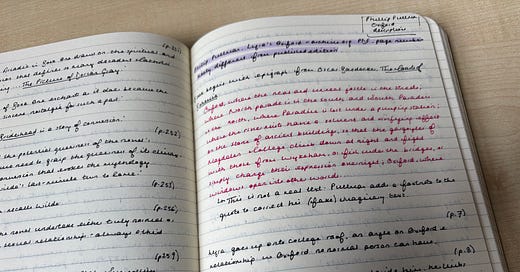



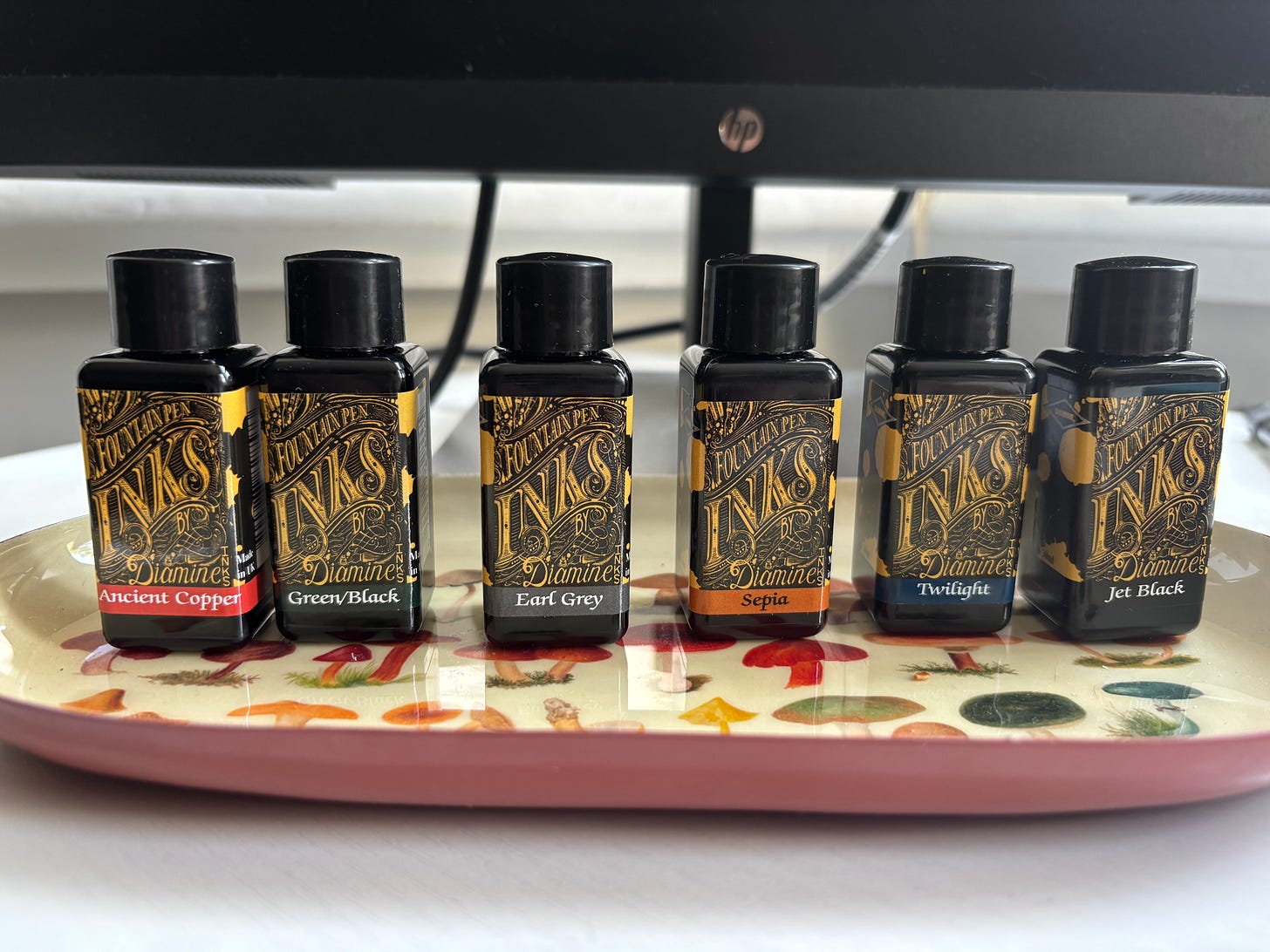
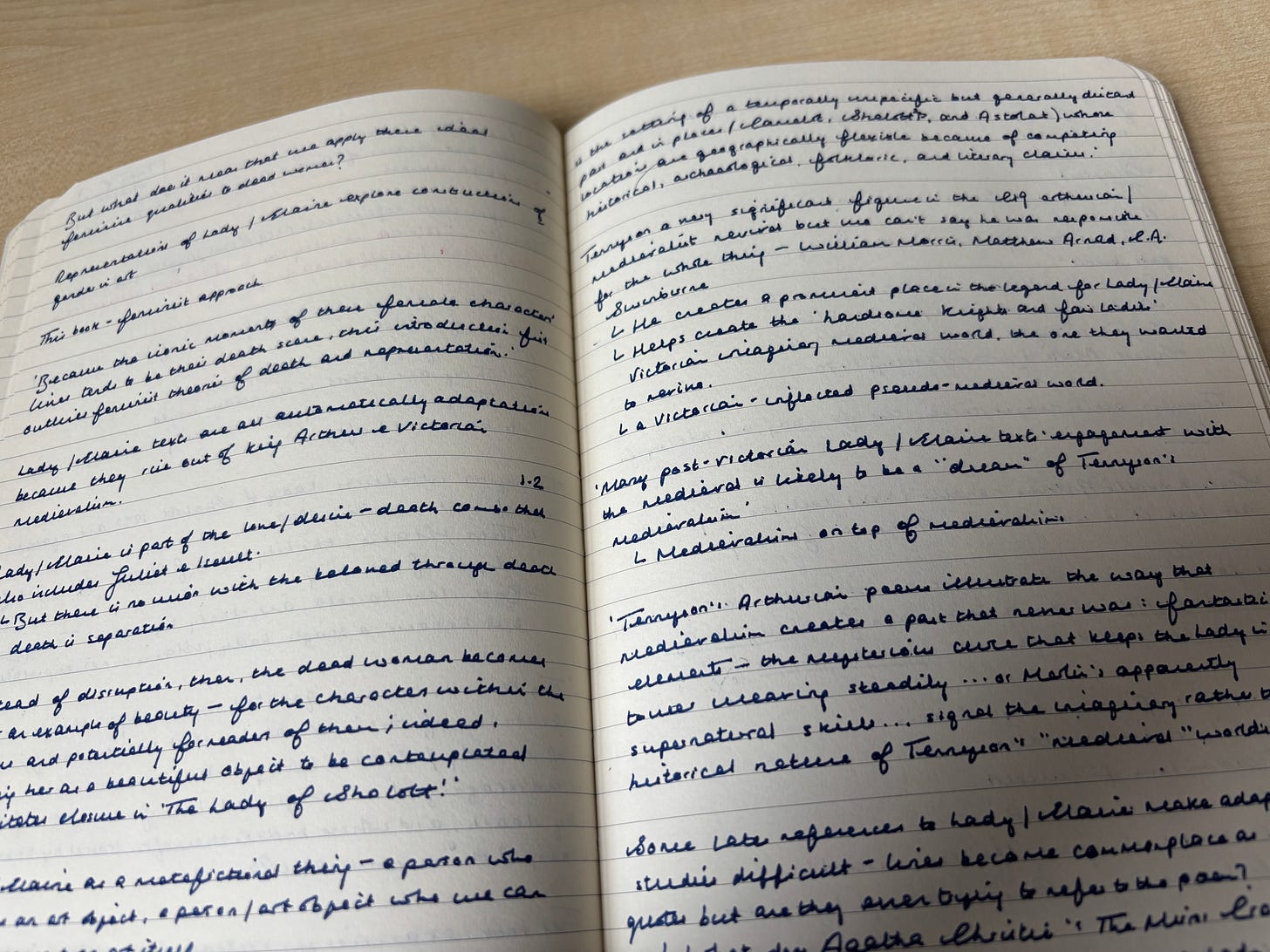

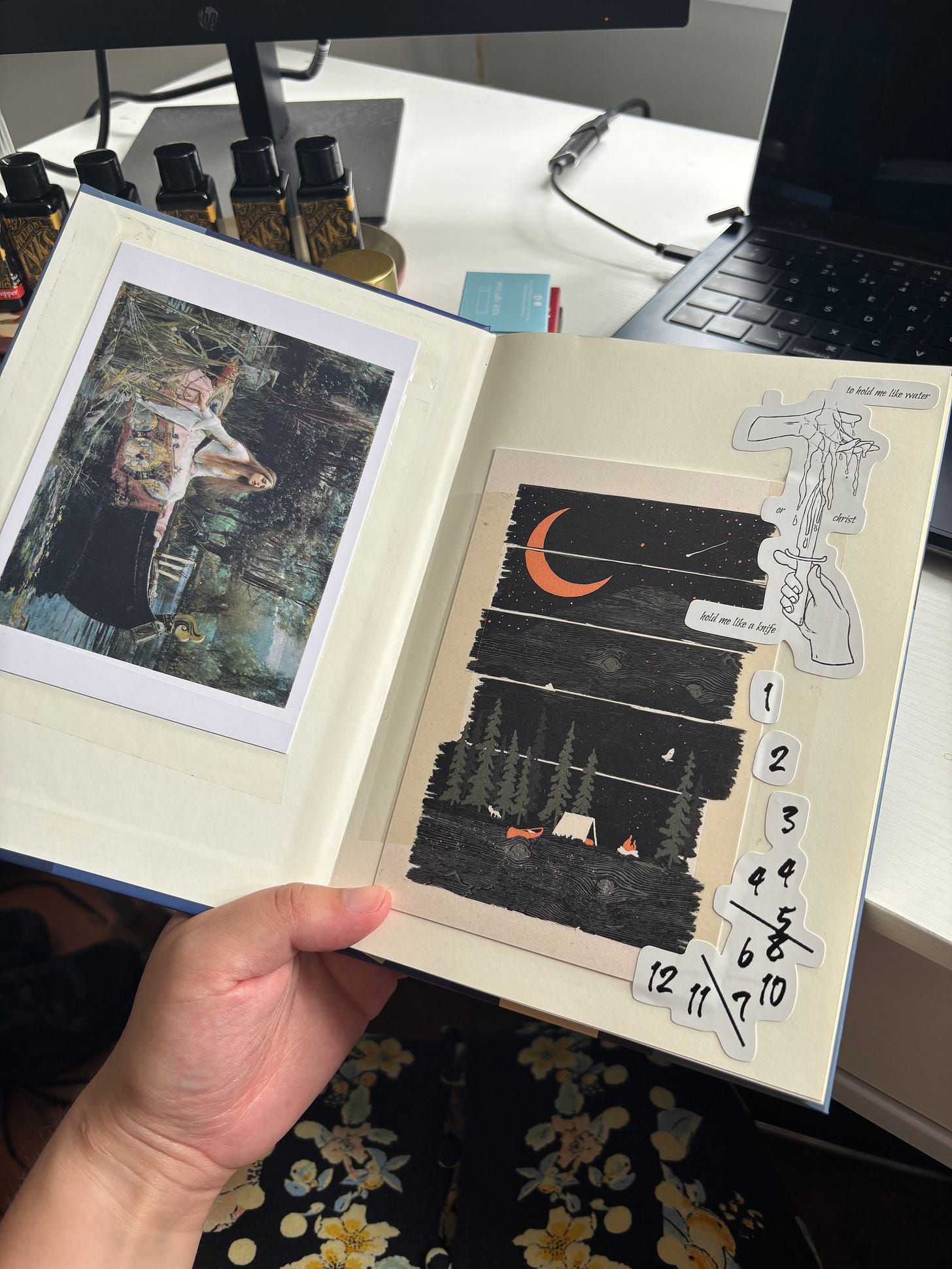
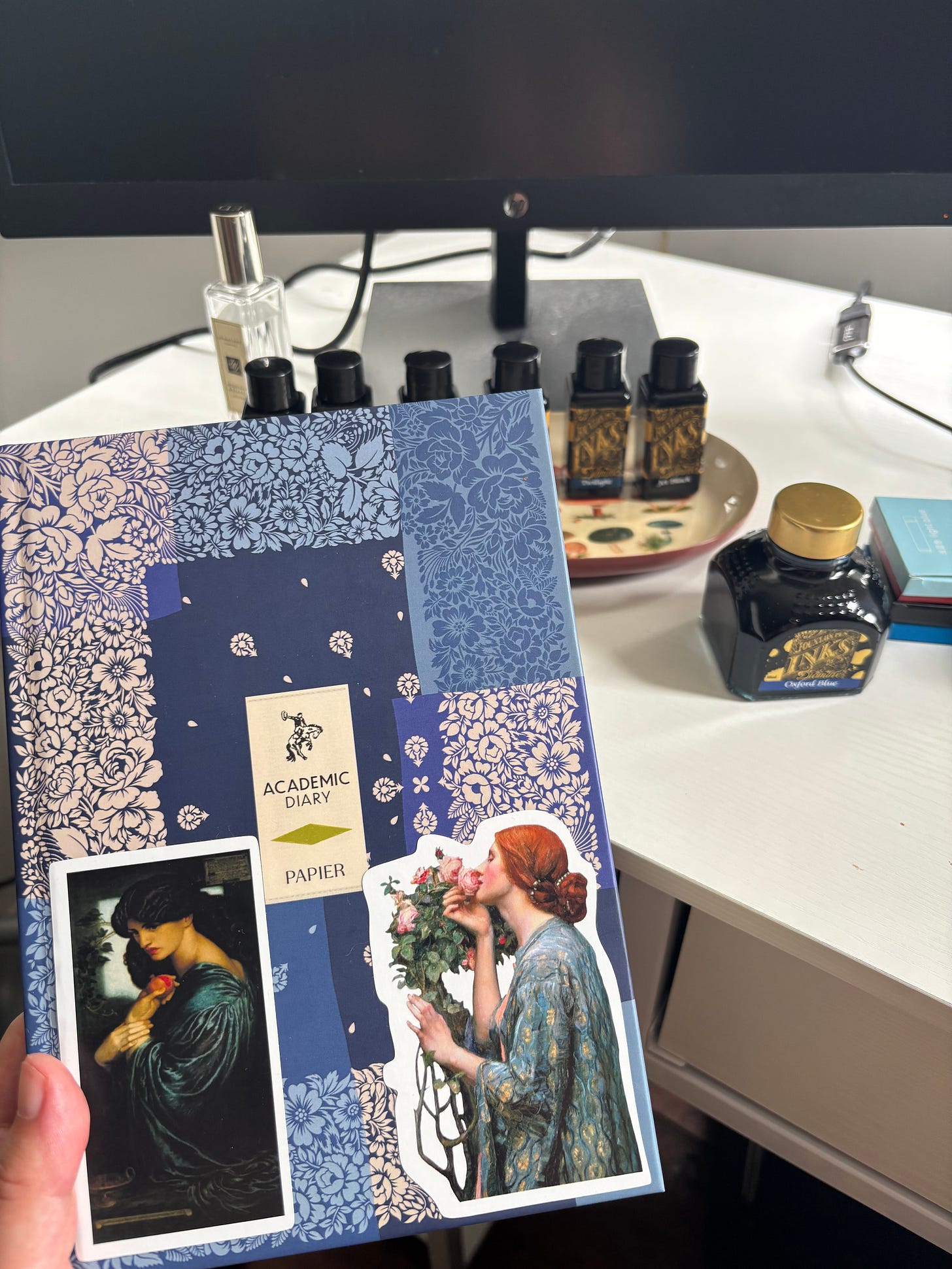

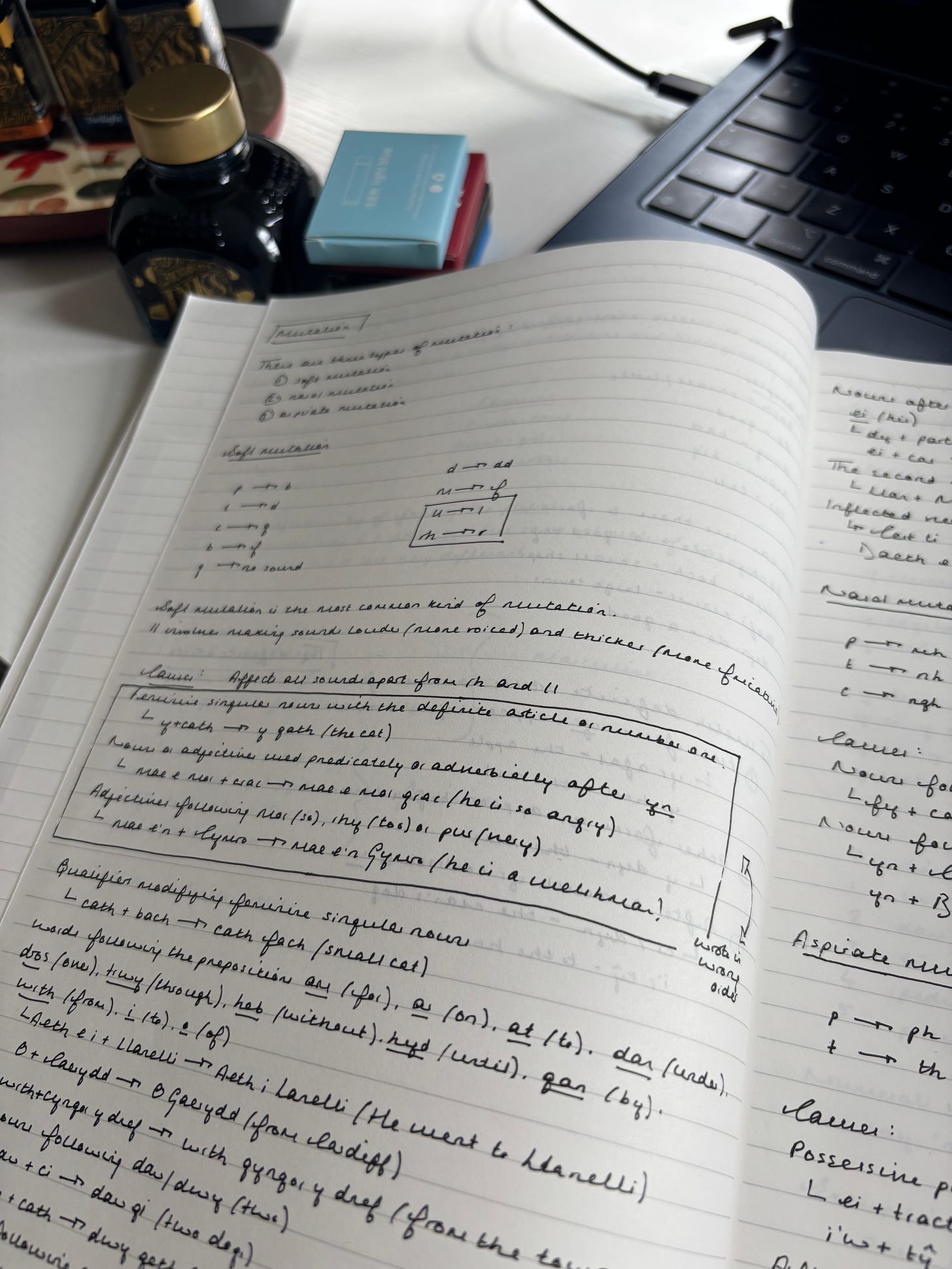
Has anyone told you that you are an absolute genius? I love how deeply you think about notebooks, especially as a notebook fanatic myself!
Also on the topic of Oxford, I thought I’d share with you recent thoughts in the hopes they resonate even a little: https://idontknowwhoneedstohearthis.substack.com/p/whats-the-point-of-an-oxford-english
I adored reading this! I recently got myself a new notebook as I am preparing to dive into my first thesis for my English degree next semester, and this just has me itching to pick up a pen and to simply get started on it. Incredibly thoughtful, and inspiring.